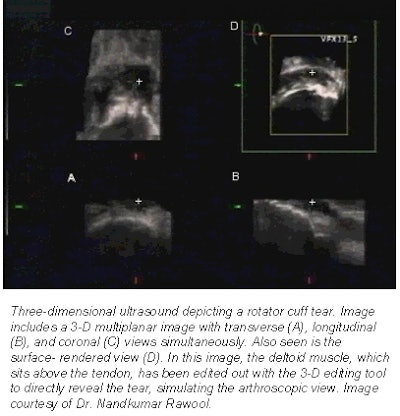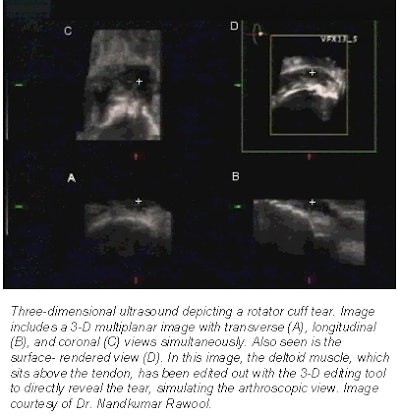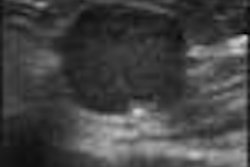
Musculoskeletal ultrasound has gotten a shot in the arm, or rather the shoulder, thanks to a Thomas Jefferson University study. Researchers found that 3D ultrasound was better than the conventional kind for visualizing the shoulder’s complex anatomy and pathologies.
The researchers called the up-and-coming technique a clinically useful complement to 2D ultrasound, especially for surgical planning, in a study presented at the 2001 American Institute of Ultrasound in Medicine meeting in Orlando.
Consider partial tendon tears, which are difficult to diagnose even with MRI, according to Dr. Nandkumar Rawool, a research associate with the Philadelphia-based university’s division of ultrasound and department of radiology. If it’s a subsurface partial tear, in which the tear is nestled against the bone and difficult to image with a conventional 2D scan, a 3D image can be digitally manipulated to offer an unobstructed view: The humerus can be deleted, and the tendon can be rotated 180º, enabling sonographers to measure the depth, width, and length of the tear.
 |
Tricks like this allow surgeons to conceptualize shoulder anatomy before they perform arthroscopic or more invasive surgeries, Rawool said. To assess the technique’s clinical value, 22 shoulders were scanned using both conventional and 3D ultrasound. Pathologies imaged include partial and complete tears, bursitis, tendinitis, and calcific tendenopathy. Sonographers found that 3D volume reconstruction offered a better global perspective of the pathology and surrounding anatomy. Three-dimensional ultrasound did not, however, change the final diagnoses.
"Two-dimensional ultrasound is still the foundation, because that’s what the diagnosis is based on," Rawool said. "But in certain cases we also conduct a 3D scan that mimics the arthroscopic view, in which the surgeon looks at a tendon head-on."
These advantages have warmed orthopedic surgeons to ultrasound’s role in pre-surgical imaging, a niche traditionally occupied by MRI, Rawool said. And while MRI will likely remain the modality of choice in imaging the knee, in which the tissue is buried beneath bone and therefore unreachable by ultrasound, ultrasound is increasingly used to image the less-obstructed tissue found in the ankle and shoulder.
Rawool’s team used a broadband transducer that can range from 8 to 15 MHz -- a far cry from the first musculoskeletal images produced 15 years ago using 7.5-MHz transducers. These low-resolution images originally gave musculoskeletal ultrasound a bad reputation, Rawool said. However, with the development of higher frequency transducers and advances in image processing software, musculoskeletal ultrasound has made significant clinical gains in recent years.
At his university, for example, Rawool and colleagues have performed both 3D ultrasound in obstetric cases and conventional ultrasound in musculoskeletal cases for about five years. In 1999, after becoming proficient in both techniques, they fused them together and began their foray into 3D shoulder ultrasound.
As with most ultrasound procedures, the technique comes with a steep learning curve -- it’s not automated like most CT and MRI procedures, Rawool said. But in the hands of experienced sonographers, the modality appears to be quite competitive. Rawool said that, armed with high-frequency probes, his team’s ultrasound images are as good or better than MR images.
And they’re cheaper. A typical 3-D shoulder sonogram runs between $300 and $400, compared to MRI’s heftier $1,200 price tag. Ultimately, this cheapness and clinical effectiveness may win over insurance companies that are reluctant to reimburse for MR exams for non-urgent cases, such as when a patient complains of minor shoulder pain, Rawool said.
The next step is to correlate the technique’s images with surgical findings, Rawool said. And don’t expect 3D ultrasound to sweep across the country overnight. For now, it will likely be refined at research institutions with access to high-end scanners, he said.
By Dan KrotzAuntMinnie.com contributing writer
June 4, 2001
Click here to post your comments about this story. Please include the headline of the article in your message.
Copyright © 2001 AuntMinnie.com



















